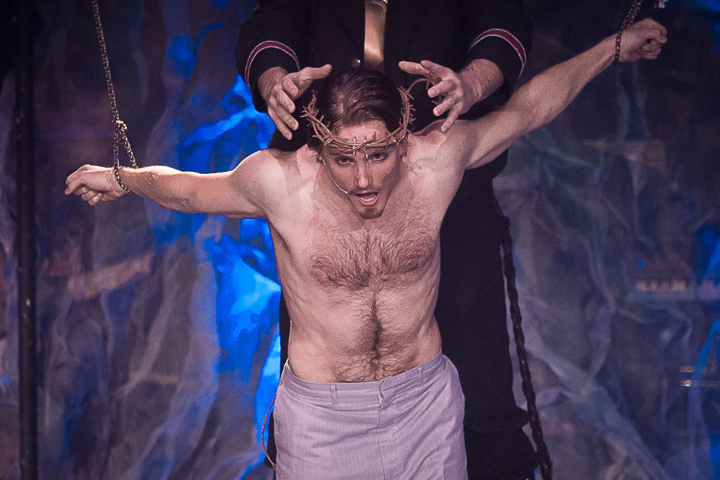Theater review: Jesus Christ Superstar: Inspired retelling pops on stage

By Alex Reyes
The Guardsman
The revolutionary spirit of the musical “Jesus Christ Superstar” was on full and glorious display on Opening Night April 19 at Diego Rivera Theatre on Ocean campus.
The Theatre Arts and Music Departments’ ambitious production features an energetic performing cast of 33, a 12-piece orchestra and a strong production staff which includes six insanely inspired costume crew members.
From the time it first appeared as an album in 1970, and then again a year later as a Broadway musical, “Jesus Christ Superstar’s” version of the final days of the “Son of God” has offered audiences a radical reintroduction to how such an uncommon man might have led his very human life in the midst of great social oppression.
The City College production dazzles the senses as the audience witnesses a society dominated by a fascistic Rome ruled by decadent and decayed emperors and their devilish black-cloaked high priest supporters, a weary Jesus comforted by a prostitute named Mary Magdalene and a healer so overwhelmed by the appeals of lepers in straitjackets that he challenges them to “heal [themselves].”
Set Designer Patrick Toebe’s land of Galilee has a heavy industrial feel, evoking a Benito Mussolini-led Rome as much as its millennia-earlier imperial rule.
A nearly stage-wide, four-step, steel colored platform is placed at the center of the stage. Square “go go” dance platforms are set on either side of the stage in line with the stairs. The platforms lead to a high walkway that lines the rear of the stage. A diaphanous crepe curtain covers the far rear of the stage, partially concealing a 12-piece orchestra.
Smoke wisps across the stage throughout the production. Strange metallic hissing and wave sounds become prominent at key times.
The cast is decked out in regalia that evokes everything from Belle Epoque bordello and cabaret life to the down-and-outers of Damon Runyon Depression-era tales to the blackness of Orwell’s “1984.” But even this attempt to describe the outfits to be seen in “Jesus Christ Superstar” stops well short of describing the nearly unbridled imagination unleashed by a six-member costume staff led by Ralph Hoy.
Zachary Bukarev-Padlo’s clean cut, goateed Jesus Christ wears a long light blue tunic with five large buttons along the right side. A partial, cotton-and-leather apron is secured by a diagonal black strap over the left shoulder. This Jesus wears matching blue pants, canvas shin protectors and brown shoes.
Bukarev-Padlo’s fine tenor voice easily evokes the fear and foreboding of the seemingly doomed lead character. Bukarev-Padlo also easily reaches the shrieking tones first recorded by Ian Gillan on the 1970 “Jesus Christ Superstar” recording.
Jenneviere Villegas’ Mary Magdalene’s red hair is matched with a red velvet bustier with an organza peplum, pink bloomers and thick high-heeled boots. Mary also sports a delightfully embellished fascinator hat.
Villegas’ strong, pure voice powers through such songs as “Everything’s Alright” and “I Don’t Know How to Love Him.” The latter song’s lines, “He’s a man/He’s just a man/And I’ve had so many men before/In very many ways,” combined with the singer’s costume, offers clear evidence of Mary Magdalene’s sketchy history.
David Peterson’s characterization of Judas Iscariot, one of history’s greatest tortured villains, is well played. A full beard and mustache, long coat, pale green vest, a necklace and watch fob amplify Peterson’s dramatic looks that include long dreadlocks.
Judas is nobody’s dummy, but he is doomed to sell out a man he loved for 30 silver coins by a force he cannot understand. Peterson gives ample voice to Judas’ anguish, confusion, hatred and love of the man he chose to follow. Again, Peterson’s shrieks match those first heard on vinyl by Murray Head in 1970.
The three lead singers are an impressive group, but “Jesus Christ Superstar” also includes showstoppers the likes of Pontius Pilate and Herod.
Ron McCan first appears as Pontius Pilate two-thirds of the way into the first act, singing the song “Pilate’s Dream.” Pilate was the Roman prefect who tried Jesus Christ and, rooted on by a mob, ordered his crucifixion.
Pilate’s throne, which looks as if it’s a wooden version of a chair designed for executions or shock treatments, matches the discombobulated nature of McCan’s Pilate. Pilate’s attire, featuring a luxurious bed jacket and pajamas, a fabulous studded long coat and, ultimately, a metallic head garland, may befit an emperor, but Pilate’s soul seems to have left his body, which moves in an odd, disconnected manner. McCan’s exit across a darkened stage after singing “Pilate’s Dream” is a tour de force.
Spencer Peterson’s Herod is another high point of the evening as much for the costume and makeup as for the great song and dance number, “King Herod’s Song.”
Another Roman ruler, Herod, struts onto the stage as a decadent dandy, face made up lightly in white makeup, bare-chested and wearing a shining red waistcoat and codpiece.
Herod’s three “Soul Girls” follow, and soon all four are dancing up a storm. Peterson gives a performance worthy of Tim Curry as Dr. Frank N. Furter in “The Rocky Horror Picture Show” or as Herod in “Jesus Christ Superstar.”
Bass-voiced David Richardson, in the role of the high priest Caiaphas, is another singing standout. At times, Richardson’s voice reaches depths from which return seems impossible.
Caiaphas’ black, leathery high priest costume, as well as his fellow priest’s authoritarian garb, is marvelous, if marvelous is the right word to describe the spot-on absolutistic attire of Caiaphas and his council.
Council members also wear fanciful eyeglasses full of wacky wiring, distorting the perspective of the wearers.
City College’s “Jesus Christ Superstar” dazzles and delights in so many ways. You owe it to yourself to see this production.
“Jesus Christ Superstar” plays April 26-27 at 8 p.m. The final performance is April 28 at 2 p.m. All performances are at Diego Rivera Theatre.

Comments are closed.